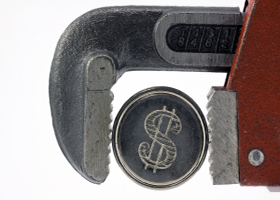


Greece’s fiscal burden highlighted other deficit-laden eurozone countries, among them Portugal, Spain and Italy, and most recently, Hungary. But, in fact, major countries face similar troubles, says Wilbur Ross, chairman and CEO of WL Ross and Company and chair of Invesco Private Capital. He likened Europe’s problems to U.S. subprime mortgage defaults at an investment forum this week sponsored by Invesco.
Instead of being an economic power, Europe has become “a lifestyle power.” It has generous retirement schemes, bloated government and restrictive labour practices. It has managed “exaggerated social benefits” by debt management. Greece’s trillion-dollar bailout only delays the reckoning. It does not solve the problem.
Despite stimulus measures, the European economy has shown scant growth – it’s down to 1% and declining, Ross notes. And it will make restructuring more difficult. “More eurozone economies have become too dependent on government largesse,” he says. “Over the half of the GDP is through government spending versus 37.5% in the United States.” At the same time, the various countries have committed to lowering their budget deficits to 3% of GDP by 2013.
Ross doesn’t think it will be easy. Greece and Spain, for example, would have to cut spending by 17% to 21%. Since half the budget is non-discretionary, discretionary spending would have to contract by 35% to 40% – “a very heavy lift.” Taxes are an option, but in many European countries, “tax fraud is a national hobby,” he says. Outside those countries, “with eurozone taxation already over 40% versus the U.S. 26.9%, raising taxes as the solution will be a problem,” he says.
“So every country must cut costs and raise taxes at the same time for several years to come,” he adds. “Imagine the bickering, the political strife and violence that will ensue. Europe is so socialistic that it cannot change itself quickly. Governments will try but rival parties will campaign against the negative economic impact.”
The future looks bleak, especially since unemployment is already a significant problem. Nor has the European Central Bank been much help. It has kept interest rates low, he notes, but has not expanded the money supply. The result is reduced economic activity. Eventually, the ECB will relent and expand the money supply, but he wonders whether that will be enough to counteract fiscal austerity. If it doesn’t, and despite budget measures Europe’s debt is likely to grow, then the weaker sovereign borrowers will be squeezed from the bond market by countries with stronger balance sheets.
Also worrisome is the state of the private sector. Half of Europe’s indebtedness arises from banks issuing debt that other banks have bought. “This vast interconnected exposure is why the bailout had to occur,” Ross says. Were Basel proposals on capital adequacy in effect now, European banks would have to raise 1.3 trillion euros in new equity. As it is, the banks are expected to write down 123 billion euros this year and 105 billion euros next year.
Which raises another dilemma. Government guarantees were required for 45% of the debt Euro banks issued. “Banks are imperiled by sovereign debt,” Ross argues, “and yet they need sovereign support and then they compete against the same sovereigns in the capital markets. This circularity is why the ECB now has downgraded sovereign debt as collateral for bank borrowers. ”
The weakness in the European economy is unlikely to have much of an impact to either the U.S. or China he adds. Still, it could make for investments opportunities. Ross says, “We expect to make more distressed investments in Europe.” But he cautions that insolvency laws in southern Europe tend to be labour-friendly.
But he’s also looking in the U.S., in the railcar industry and among failed U.S. banks. Also, with “a sputtering economy and U.S. manufacturing at 72% capacity, more companies will be unable to finance their debt.”
That’s the upbeat word in the downbeat news.
Other Invesco managers were a little cheerier.
Doug Gooding, who manages global funds for Invesco in Atlanta, finds value in Canada. Where in the past it used to command a 0% to 2% share of the portfolio, it’s now up 6% or 7%.
But he also cautions that investors have come off “one of the very best 12 month periods we’ve seen in 75 years.” Investment leadership seems to have changed: the U.S. and Japan were significant laggards, while emerging markets were the best performers.
Overall, he thinks stocks face a “very healthy backdrop with strong underpinnings – the strength in stocks is justified.” He also argues that risk appetites have returned to normal.
That said, stocks are not as cheap as they were. “We think they’re fairly valued,” he says, “ in the middle of their long-term range.”
Heather Hunter, who manages Canadian equities at Invesco Trimark in Toronto says that while Canada has emerged from a relatively mild recession, nevertheless the economy remains bound to the U.S., which used to buy 80% of Canada’s exports, now down to 75%. Who’s taking it’s place? It’s not Europe, which historically has absorbed 3% to 5% of Canada’s exports. Instead, its emerging markets; exports have doubled.
After a decade of sub-par stock returns, Jan Friedli, head of global fixed income for Invesco, thinks fixed income looks pretty good – with some caveats. Over the past decade, bonds have outperformed stocks, except in emerging economies.
He figures that the stocks will return 6% to 7% in nominal terms, unless there’s a multiple expansion. Stock returns are fairly predictable then, driven by earnings growth that reflects nominal GDP growth, plus dividend yields. By contrast, bonds are set to yield 4%. Corporate and high-yield bonds could push the yield to 5.5%. But in each case, the investor is assuming duration risk -– not a particularly good place to be when interest rates start to rise. Instead, he prefers senior secured loans, corporate loans with a floating interest rate.
